
Insects and Flowers
Roger Farrow
Insects are a familiar sight on the flowers of our native plants and their role in the pollination of flowering plants is well known. How did this relationship develop? This article describes some of the different ways in which insects currently relate to flowers and how this may reflect the evolutionary processes that have occurred between insects and flowers. This type of process is often described as co-evolution because each partner in the relationship has functional adaptations to exploit the relationship.
 |
|
Fig 1 - Cycad weevels on Bowenia sp.
Photo: Roger Farrow |
|
Ancestral members of most of the currently recognised major Insect Orders (see box on next page) appeared in the Carboniferous and Permian Eras of the Palaeozoic, starting 300 million years ago (mya), long before the appearance of the angiosperms or flowering plants which occurred as late as the Cretaceous era, 100 mya. The Carboniferous and Permian was dominated by spore- and cone-bearing plants including spore and seed-bearing ferns, club mosses, cycads and primitive conifers. Following the mass extinctions at the end of the Permian the remaining orders of insects appeared in the Triassic and Jurassic, 230 -180 mya, when the forests were dominated by pollen-producing cycads and conifers.
What were the insects of the Palaeozoic feeding on? There was a predominance of species with sucking mouthparts, much greater than in today's fauna. These were suitable for imbibing spores and pollen or sucking juices from tissues including cones and seeds. A few were predators and detritus feeders. Most disappeared at the great Permian extinction. In the Triassic and Jurassic all the modern orders were present and a wide range of food sources were utilised. Ancestral moths, for example, had jaws and fed on pollen like some modern species, although most modern moths appeared in the Cretaceous after the rise of the angiosperms and have highly specialised sucking mouthparts for imbibing nectar.
It was generally assumed until recently that all non-flowering plants were wind pollinated. While this it is true for modern and probably ancestral conifers it has been recently shown that modern cycads are pollinated by a particular group of weevils in whatever continent they have been investigated. Weevil pollination of the stemless cycad Bowenia in our tropical rainforests has been extensively studied. The relationship is more than a simple pollination process as the weevils lay their eggs in the male cones and the larvae cannot develop anywhere else (Fig.1). This is an intimate relationship which benefits both beetle and cycad and is known as a symbiosis. Beetles, including weevils, coexisted with cycads in the Triassic and Jurassic and it is probable that they were involved in the pollination process. One of the primitive rainforest angiosperms of our rainforests, the bolwarra, Eupomatia laurina, a small tree with cauliflorous flowers (borne on the trunk), also has a symbiotic relationship with a weevil pollinator. Beetles are thought to be the first pollinators of the angiosperms, possibly as predators of other flower-inhabiting insects or as pollen feeders. Most insects are covered in hairs and bristles and pollen grains are naturally trapped in these structures. Most insects fly and are pre-adapted for the transport of pollen between plant reproductive structures.
Insect classification
Flowering plants belong to one order - the Angiospermae - and are broken up into numerous families. Insects, on the other hand, belong to a number of characteristic orders, each of which comprises a variable number of families.
The principle orders discussed here are: grasshoppers (Orthoptera), bugs (Hemiptera), beetles (Coleoptera), wasps and bees (Hymenoptera), flies (Diptera), and butterflies and moths (Lepidoptera). The bugs and grasshoppers belong to a sub-order in which the immature stages are similar to the adults, the wings develop externally and they usually feed on the same host. In contrast, beetles, wasps, flies, and moths belong to another sub-order characterised by a grub-like larval stage, quite different from the adult, in which the wings develop internally and which may feed differently from the adult.
Classifying flower visitors
I have divided visitors that are commonly seen on flowers and that I have photographed into: 1) petal and anther feeders; 2) pollen feeders and collectors; 3) pseudo-copulators; 4) nectar feeders; 5) predators; and 6) accidentals.
1) Petal and anther feeders
Grasshoppers, beetles and moth larvae are often seen feeding on flower structures but are not directly involved in the pollination process. They basically have simple chewing mouthparts (Figs 2,3,4).
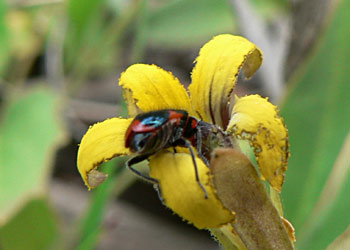 |
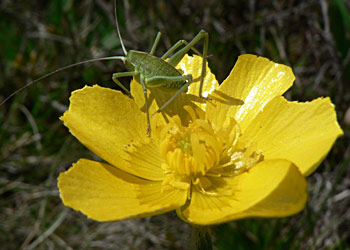 |
Fig 2 - The beetle Dicranolaius on Velleia paradoxa (left). Fig 3 - Katydid Caedicia simplex on Ranunculus (right).
Photos: Roger Farrow. |
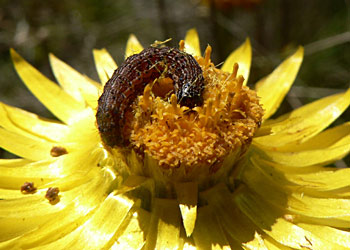 |
Fig 4 - Caterpillar Heliothis punctigera on
Xerochrysum sp. Photo: Roger Farrow. |
2) Pollen feeders and collectors
It is often difficult to distinguish between some pollen and nectar feeders, especially those feeding in flowers where the stamens and nectaries are close together such as the Myrtaceae. Most beetles have simple chewing mouthparts and feed on the anthers, trapping pollen grains in their hairs and bristles and transferring them from flower to flower (Figs 5,6,7). Bees take this a step further by collecting pollen in specialised baskets of bristles on their legs and abdomen to feed their larvae (Fig 8). Although flies have sucking mouthparts, many - such as the hover flies - principally feed on pollen (Figs 9,10,11) and transfer pollen on their mouthparts. Many pollen-feeding species are also attracted to wind pollinated plants because of the abundance of pollen.
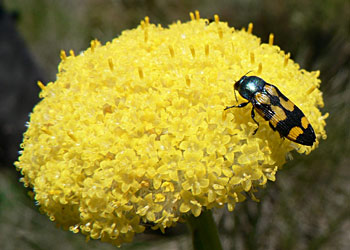 |
 |
Fig 5 - Jewel beetle on Crepis (left). Fig 6 - Pollen beetles, Mordellidae, on Brachyscome (right).
Photos: Roger Farrow. |
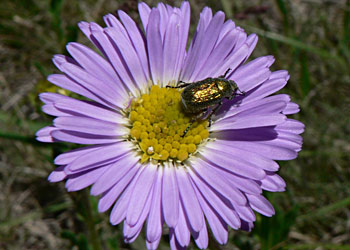 |
 |
Fig 7 - Scarab Diphucephala on Callotis (left). Fig 8 - Solitary bee on Xerochrysum (right).
Photos: Roger Farrow. |
 |
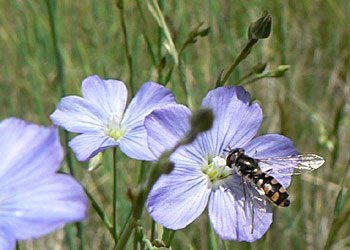 |
Fig 9 - Family Tephritidae on Craspedia (left). Fig 10 - Hoverfly Syrphidae on Linum (right).
Photos: Roger Farrow. |
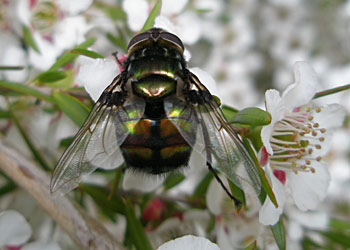 |
| Fig 11 - Tachinid fly on Leptospermum Photo: Roger Farrow. |
3) Pseudo-copulators
Besides colour, flowers also attract pollinating insects by the release of scent. Many insects also use a scent or pheromone to attract the opposite sex. One family of plants, the orchids, have taken this one step further, by producing a pheromone-mimicking scent to attract males of a specific insect species, many of them parasitic wasps. There are also physical attributes of the flower which mimic the female of the insect species so the male attempts to copulate with the flower and receives the pollinia which are transferred to another flower of the same species by the same process. Unfortunately I have no photos of this event.
4) Nectar feeders
Most flowers use nectar to attract pollinators. Nectaries are positioned to ensure that the visiting insect brushes against anthers and stigma. Moths and butterflies have co-evolved with the angiosperms through the development of extensible sucking mouthparts. Bees and some wasps and flies also have sucking mouthparts adapted to nectar feeding (Fig 12). All bugs have sucking mouthparts but few feed on flowers. Nectar is a great energy source for flying insects and a wide range of wasps and flies utilise nectar as a primary energy source (Fig 13). Some may actually rob the nectary and by-pass the anther and stigmas (Fig 14). Most moths are night-flying and my photos only record those seen by day, mostly species distasteful to predators (Family Arctidae, Figs 15,16). Note the proboscis of the butterflies (Figs 17,18) and moths.
 |
 |
Fig 12 - Scoliid wasp on garlic (left). Fig 13 - Ichneumonid wasp on Bursaria (right).
Photos: Roger Farrow. |
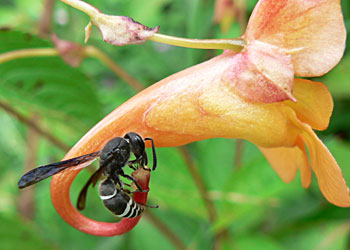 |
 |
Fig 14 - Wasp robbing Impatiens nectary (left). Fig 15 - Pollanisus moth on snow gum (right).
Photos: Roger Farrow. |
 |
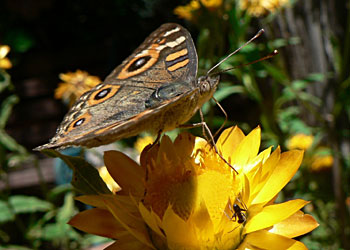 |
Fig 16 - Utetheisa moth on Podolepis (left). Fig 17 - Meadow argus on Xerochrysum (right).
Photos: Roger Farrow. |
 |
| Fig 18 - Grass skipper on Xerochrysum Photo: Roger Farrow. |
5) Predators
Where insect prey is available, predators will lurk - and so it is with flowers. Ambush predators such as spiders (Fig 19) and assassin bugs (Fig 20) often wait on or next to flowers to capture unsuspecting prey.
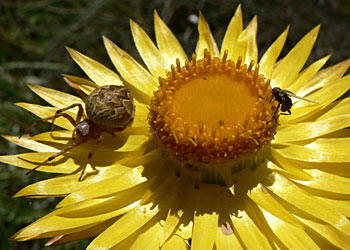 |
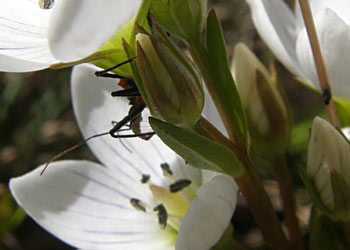 |
Fig 19 - Spider on Xerochrysum (left). Fig 20 - Assassin bug lurking below gentian flower (right).
Photos: Roger Farrow. |
6) Accidentals
Some insects, such as this grasshopper, are seen wandering over flowers when they have no specific purpose there (Fig 21). Others may climb flowers for a vantage point to take-off in flight.
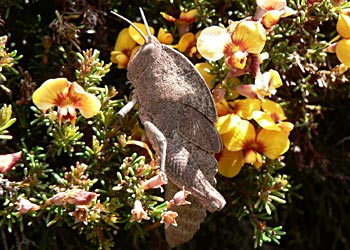 |
| Fig 21 - Gumleaf grasshopper numph on Dilwynnia Photo: Roger Farrow. |
From the newsletter of the Australian Native Plants Society (Canberra), September 2008.
Australian Plants online - 2009
Australian Native Plants Society (Australia)
|